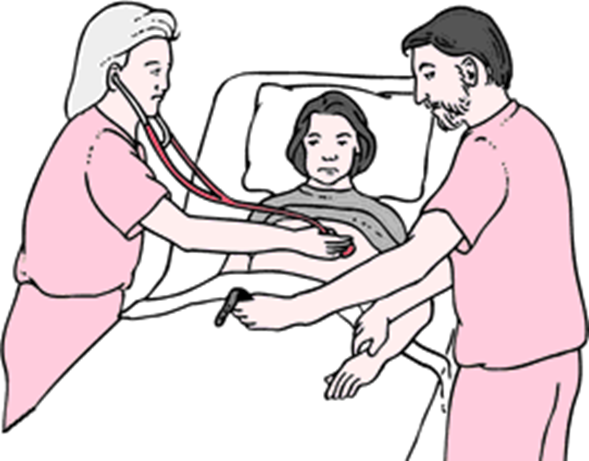A nurse is caring for a client who is experiencing anxiety as well as numbness and tingling of the lips and fingers. The client's ABGs are pH 7.48, PCO2 30 mm Hg, HCO3 24 mEq/L, PaO2 85 mm Hg. Which of the following acid-base imbalances should the nurse identify that the client is experiencing?
Respiratory alkalosis.
Respiratory acidosis.
Metabolic alkalosis.
Metabolic acidosis.
The Correct Answer is A
Choice A rationale:
The client's ABG values show a pH of 7.48, PCO2 of 30 mm Hg, HCO3 of 24 mEq/L, and PaO2 of 85 mm Hg. The elevated pH and decreased PCO2 (respiratory component) suggest respiratory alkalosis. Respiratory alkalosis occurs when there is excessive ventilation, leading to a decrease in carbon dioxide levels (hypocapnia) and subsequent alkalosis.
Choice B rationale:
Respiratory acidosis is characterized by an elevated PCO2 and decreased pH. In this case, the client's PCO2 is decreased, indicating respiratory alkalosis rather than respiratory acidosis.
Choice C rationale:
Metabolic alkalosis is characterized by an elevated HCO3 (bicarbonate) level and an increased pH. The client's HCO3 level is within the normal range, making metabolic alkalosis an incorrect identification.
Choice D rationale:
Metabolic acidosis is characterized by a decreased HCO3 level and a decreased pH. The client's HCO3 level is within the normal range, ruling out metabolic acidosis as the acid-base imbalance in this case.
Nursing Test Bank
Naxlex Comprehensive Predictor Exams
Related Questions
Correct Answer is B
Explanation
Choice A rationale:
Providing a continuous passive motion (CPM) device is not necessary for a client following a total hip arthroplasty. CPM devices are more commonly used after knee arthroplasty to improve joint mobility.
Choice B rationale:
Ensuring the client has an elevated toilet seat at home is important following a total hip arthroplasty. The elevated seat reduces the amount of hip flexion required during toileting, which helps prevent hip dislocation and strain on the surgical site.
Choice C rationale:
Providing a trapeze bar is not essential for a client following a total hip arthroplasty. Trapeze bars are typically used to assist with repositioning in bed for clients with limited mobility, but they are not specific to hip arthroplasty recovery.
Choice D rationale:
Providing a compression garment is not necessary after total hip arthroplasty. Compression garments are often used for conditions like venous insufficiency or to manage swelling, but they are not routinely used for hip arthroplasty recovery.
Correct Answer is B
Explanation
Choice A rationale:
A capillary refill of less than 1 second is a normal finding and indicates adequate peripheral perfusion. It is not a cause for concern in this postoperative client.
Choice B rationale:

The presence of a pulse deficit should be reported to the provider because it suggests a discrepancy between the apical and radial pulses, indicating potential cardiovascular compromise or inadequate arterial perfusion.
Choice C rationale:
A systolic blood pressure 10 points lower than before surgery can be a normal response to anesthesia or surgery and may not necessarily require immediate reporting unless accompanied by other concerning symptoms or vital sign abnormalities.
Choice D rationale:
Pulse oximetry at 96% is within the normal range for oxygen saturation and does not warrant immediate reporting. However, if the client is experiencing respiratory distress or other concerning symptoms, it should be addressed promptly.
Whether you are a student looking to ace your exams or a practicing nurse seeking to enhance your expertise , our nursing education contents will empower you with the confidence and competence to make a difference in the lives of patients and become a respected leader in the healthcare field.
Visit Naxlex, invest in your future and unlock endless possibilities with our unparalleled nursing education contents today
Report Wrong Answer on the Current Question
Do you disagree with the answer? If yes, what is your expected answer? Explain.
Kindly be descriptive with the issue you are facing.
